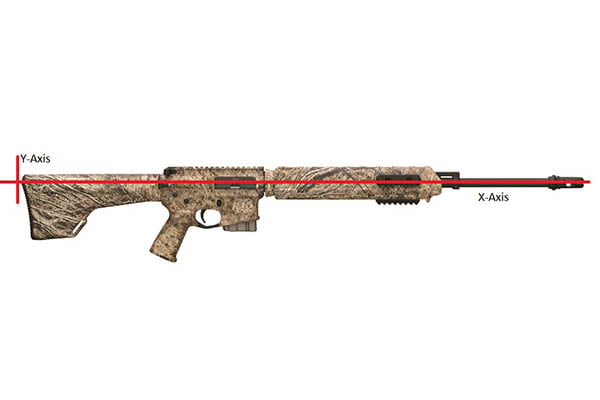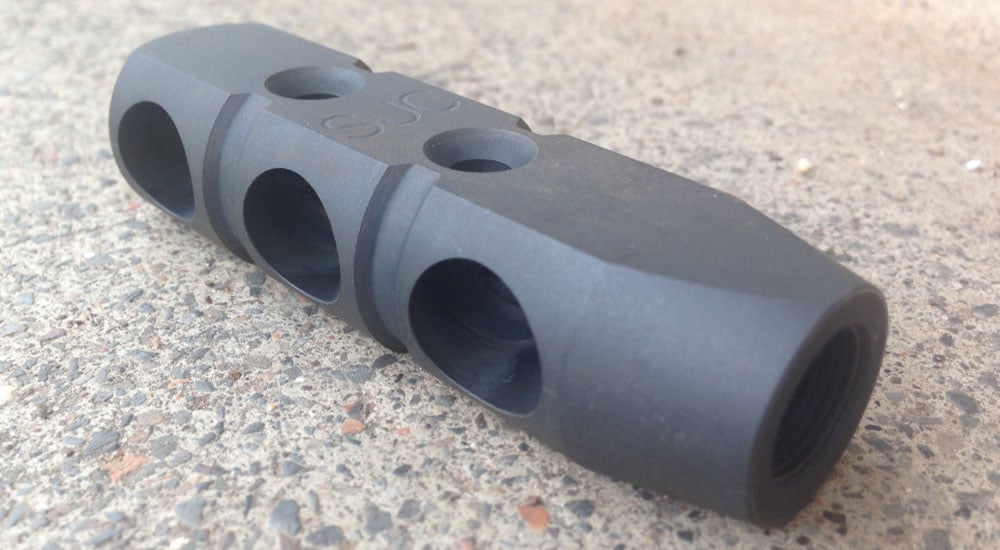
Last Updated on
If you’ve shot a rifle bigger than a .22 Short, or any shotgun for that matter, you’re intimately familiar with the concept of recoil as it pertains to firearms. But what actually causes this (sometimes painful) “kick?” And is there anything we can do about it?
Where does recoil come from?
Newton’s third law clearly states that “For every action, there is an equal and opposite reaction.” When a fired bullet quickly moves forward relative to the shooter, a distinct and opposite reaction does indeed occur.
This reaction is a function of the bullet’s mass and unique velocity. In a nut shell: There’s no such thing as a free lunch. Bigger calibers are going to equal bigger recoil, and the inverse is true as well. The recoil reaction is equal and opposite, after all.
Also, if you ever see a movie where somebody gets blasted with a shotgun and subsequently gets tossed across the room, you now know why this is absurd. If small arms were actually capable of that kind of damage, the shooter would also go flying, but in the opposite direction!
Perceived Recoil vs. Actual Recoil
Recoil doesn’t happen in an ideal, closed system. While we can easily calculate the force produced by a bullet while it’s still traveling down the barrel, it’s not an effective way to express how those forces interact with a shooter, especially when different firearms in the same caliber are used. For instance, a side-by-side 12 gauge shotgun will feel very different as compared to a cutting-edge semi-auto also chambered in 12 gauge.
Many factors influence how we feel recoil. Louder firearms can be perceived to kick more, and a large concussion and muzzle flash also contribute to the sensation of this felt recoil. Obviously, we don’t really care about the actual recoil. All that we’re practically concerned about with is how we perceive the forces enacted on the firearm by the fired bullet, and how it translates to our shooting situation.
What can we do to mitigate recoil?
Obviously, more recoil is never a good thing. Hard-kicking rifles and shotguns can cause accuracy-robbing flinches, and can make long days at the sporting clays field or range pretty miserable. Even with lighter caliber guns (like the AR-15), recoil can cause the sights and muzzle to rise up and off the target enough to hurt scores and dramatically slow down follow-up shots.
Thankfully, there are a number of ways to reduce (and sometimes practically eliminate) perceived recoil.
1. Start with an effectively designed firearm
We’re all familiar with traditional hunting rifle stock design, where there’s a defined wrist and subsequent drop at the comb. Drawing imaginary lines horizontally through the barrel and vertically to the butt pad shows us why this isn’t ideal for minimizing recoil.
This image presents us with the engineering principal known as a “moment arm”, represented by the Y-Axis. The greater the length of the moment arm, the greater felt recoil will be. This makes sense, because the recoil force exerted along the X-Axis has a long lever to act upon, thanks to the difference caused by the stock wrist and the drop in the comb.
If the axis of force (the barrel, in this case) can be moved more in line with the pivot point (your shoulder), recoil will greatly be reduced because the moment arm has been significantly reduced, if not completely eliminated. Happily, the AR-15 does exactly that, making them a great choice for shooters wanting a low recoiling rifle.
Not only do AR-15 style rifles and their larger caliber derivatives offer more efficient, recoil friendly designs from an objective engineering standpoint, but they also showcase another feature that helps with recoil: A gas system.
All semi-automatic rifles recoil less than their bolt-action counterparts, caliber-for-caliber and weight-for-weight. Since the moving parts begin recoiling at a higher rate of speed than the rest of the firearm, the peak recoil forces are greatly reduced. Also, the recoil is spread out over a longer period of time, which lessens the kick as well.
2. Install one or more mercury recoil reduction systems
This method isn’t as common as it used to be, but it still works quite well. Mercury recoil reducers are a hollow, tubular container that houses mercury, which is a liquid at room temperature. Independent movement of this dense liquid metal upon firing helps to noticeably dampen felt recoil.
Installation may be as easy as removing the butt plate of your rifle or shotgun, and dropping the device into the bolt hole. If you aren’t so lucky, it’s a simple procedure to simply drill a long hole into the stock to accept the recoil reducer.
As a side benefit, the added heft towards the rear can improve the balance of your long gun. This isn’t always the case, so it may be necessary to add forend balance weights to preserve the fine handling of your quail hunting shotgun.
3. Thread on a muzzle brake
This option is becoming quite popular, even on lighter calibers. Many rifles today come from the factory with threaded muzzles, which makes it easy to simply twist on a brake. Contrary to popular belief, brakes don’t work by simply venting gasses sideways. Rather, they give the gasses exiting the muzzle a perpendicular surface to strike against, which thrusts the entire gun forward.
Typically, the more surface area the perpendicular faces of the brake have, the more effective it is. Unfortunately, this also means that effective muzzle brakes come with punishing concussion and blast, especially towards the side of the rifle. However, many muzzle brakes give you an excellent option for taking advantage of the next method of recoil reduction.
4. Put a suppressor on your muzzle brake
In addition to significantly reducing muzzle blast, sound suppressors help noticeably tame recoil as well. If the two to three blast chambers of a muzzle brake can greatly reduce recoil, just imagine what a suppressor full of baffles can do!
Furthermore, since a suppressor greatly limits (and eliminates, in some calibers) muzzle blast, perceived recoil will be less as well. Suppressors are fast becoming a mainstream item in the firearms industry and for good reason.
5. Slip on a recoil pad
Whether for yourself or your rifle, a rubber recoil pad can go a long way towards making a day at the range more comfortable. Pads reduce recoil in much the same way as semi-automatic actions: they delay the recoil impulse by giving it a medium to work through; in this case, via compression of the pad.
Adding a rubber pad can change the length of pull on your shotgun or rifle, so stock shortening may be required. Alternatively, a thin strap-on shoulder pad will increase comfort without any changes to your firearm. As a plus, strap-on shoulder pads work with every single gun you own without modification.
6. Shoot lighter loads
As was stated at the beginning of this article, recoil is a direct and opposite reaction of the bullet traveling down the barrel and leaving the muzzle. Lower the mass traveling down the barrel and reduce the velocity at which it does so, and you’ll get less recoil.
Depending on your application, this might not be an option. Competition shooters are normally required to shoot a certain minimum “power factor,” which is calculated by the mass and velocity of the projectile. Hunters might want very powerful loads depending on their quarry, and defensive rifle loads are usually more effective when loaded on the hotter side.
However, trap and skeet shooters can usually get away with lighter practice loads. As usual, ammunition selection depends on your unique situation.
Mix and Match These Methods
Combining two or more of the above listed methods will stack the benefits and provide even more recoil reduction. Finding the perfect combination of methods and technique could mean the difference between a rifle you only want to shoot once and a companion that you’ll reach for season after season.
What are you favorite ways to soak up recoil? Let us know in the comments below!







Leave a Reply